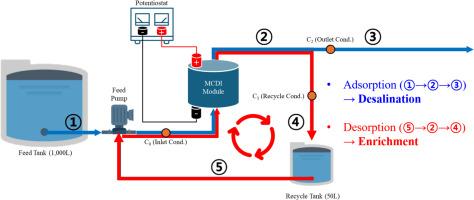循环型MCDI作为离子去除和富集双功能系统的评价
IF 9.8
1区 工程技术
Q1 ENGINEERING, CHEMICAL
引用次数: 0
摘要
传统的膜电容去离子(MCDI)在结构上受到限制,因为吸附和解吸在同一进料流上进行,导致产物收率低,并且在再生过程中不断产生低盐度盐水。我们之前介绍了循环型MCDI (C-MCDI)的概念,并证明了其提高产水量的潜力。然而,对C-MCDI的研究主要集中在提高水回收率或修饰细胞结构上,很少关注离子富集的机制,也没有实验验证C-MCDI作为离子富集体系。因此,我们系统地评估了C-MCDI的富集性能和全周期能量需求。我们对MCDI和C-MCDI在222-4000 μS/cm NaCl溶液中进行了20次循环实验,比较了它们的性能,明确了C-MCDI在循环运行下的双功能性能。我们发现,在两个系统中,离子去除效率始终保持在80%以上。吸附过程中的比能耗(SEC) MCDI为0.17-2.87 kWh/m3, C-MCDI为0.14-4.88 kWh/m3,证实了两种构型的低能量潜力。相比之下,C-MCDI解吸过程中的SEC增加到6.53 kWh/m3,表明与富集相关的额外能量负担。为了定量评估这种权衡,我们提出ΔC(绝对浓度差),定义为回收罐和进料流之间的电导率差。总体而言,本研究提供了迄今为止最全面的实验评估,将C-MCDI作为具有脱盐和富集双重功能的平台,同时强调了解吸过程中的能耗降低和长期稳定性是未来实际应用的关键挑战。本文章由计算机程序翻译,如有差异,请以英文原文为准。

Evaluating circulation-type MCDI as a dual-function system for ion removal and enrichment
Conventional membrane capacitive deionization (MCDI) is structurally constrained because adsorption and desorption are carried out on the same feed stream, resulting in low product yield and the continuous generation of low-salinity brine during regeneration. We previously introduced the concept of circulation-type MCDI (C-MCDI) and demonstrated its potential for improving water yield. However, research on C-MCDI has largely focused on enhancing water recovery or modifying cell architecture, with little attention to the mechanisms of ion enrichment and no experimental validation of C-MCDI as an ion enrichment system. Therefore, we systematically evaluated the enrichment performance and full-cycle energy demands of C-MCDI. We conducted 20-cycle experiments on MCDI and C-MCDI using NaCl solutions (222–4000 μS/cm) to comparatively assess their performance and clarify the dual-function capability of C-MCDI under cyclic operation. We found that ion removal efficiencies were consistently maintained above 80 % in both systems. Specific energy consumption (SEC) during adsorption was 0.17–2.87 kWh/m3 for MCDI and 0.14–4.88 kWh/m3 for C-MCDI, confirming the low-energy potential of both configurations. In contrast, the SEC during desorption in C-MCDI increased up to 6.53 kWh/m3, indicating an additional energy burden associated with enrichment. To quantitatively assess this trade-off, we propose ΔC (absolute concentration difference), defined as the conductivity difference between the recycle tank and the feed stream. Overall, this study provides the most comprehensive experimental evaluation to date of C-MCDI as a dual-function platform capable of both desalination and enrichment, while highlighting energy reduction during desorption and long-term stability as critical challenges for future practical applications.
求助全文
通过发布文献求助,成功后即可免费获取论文全文。
去求助
来源期刊

Desalination
工程技术-工程:化工
CiteScore
14.60
自引率
20.20%
发文量
619
审稿时长
41 days
期刊介绍:
Desalination is a scholarly journal that focuses on the field of desalination materials, processes, and associated technologies. It encompasses a wide range of disciplines and aims to publish exceptional papers in this area.
The journal invites submissions that explicitly revolve around water desalting and its applications to various sources such as seawater, groundwater, and wastewater. It particularly encourages research on diverse desalination methods including thermal, membrane, sorption, and hybrid processes.
By providing a platform for innovative studies, Desalination aims to advance the understanding and development of desalination technologies, promoting sustainable solutions for water scarcity challenges.
 求助内容:
求助内容: 应助结果提醒方式:
应助结果提醒方式:


